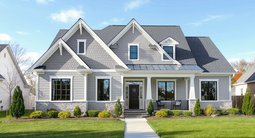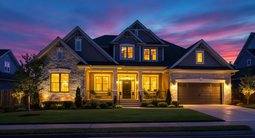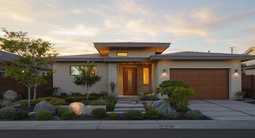TL;DR
If your front elevation design feels mismatched, start by committing to a single architectural style, choosing climate‑ready materials, and fixing scale, symmetry, and alignment. Use an ai home decorator like ReimagineHome AI to preview changes; long before demo day you can test window colors, siding, and lighting with how to design a front elevation with AI for faster, smarter decisions.
Why some elevations never quite land

Spot the difference: cluttered designs vs. harmonious front elevations with clear style choices.
Front elevation design is the curb-appeal engine: it blends architecture, materials, proportions, and light into one clear story. When the story gets muddled—style mashups, flimsy cladding, odd window choices—your eye knows something’s off even if you can’t say why. Here’s the thing: small misalignments snowball. Modern visual tools like ReimagineHome.ai make it painless to diagnose and fix. Upload a photo, test fiber‑cement vs. vinyl siding, swap black vs. white windows, or preview metal roof accents with room design ai speed. With ai interior design from photo and ai landscape design, you’ll see the impact of every choice before you spend a dollar on materials.
The fix-first plan: a clear front elevation strategy

A straightforward, repeatable front elevation plan clarifies architectural proportions and material zones.
Front elevation design benefits from a simple, repeatable plan you can preview with an ai home decorator like ReimagineHome.ai. 1) Commit to one style Pick a primary language—Craftsman, Farmhouse, Modern, Tudor—and let it drive every exterior decision. Experts recommend keeping 80–90% of the facade in one style, with only 10–20% reserved for complementary accents. 2) Balance massing and symmetry Align elements on the same wall plane. When you introduce a gable, pull the wall below forward 8–16 inches so the form reads as intentional. A rule of thumb: second‑floor windows flanking an entry should match height and head alignment within 1 inch to avoid visual wobble. 3) Choose climate-appropriate materials In hot, UV‑intense zones, aluminum sheet wraps can ripple; fiber‑cement or treated wood cladding resist warping. In hail‑prone regions, thicker (5/16-inch) fiber‑cement often outperforms thin vinyl in impact resistance. Experts recommend overhangs of 18–24 inches on south and west facades to protect finishes and cut solar gain. 4) Set trim, color, and contrast by style Craftsman thrives on light trim (3.5–5.5-inch) around medium siding; Modern leans monochrome with minimal reveals; Farmhouse favors vertical siding, high-contrast windows, and metal accents. A clean color rule: limit the facade to one field color, one trim, and one accent (1–1–1) for cohesion. 5) Prioritize entry hierarchy Your front door should be the most legible focal point. Sidelights or a transom work well; size exterior sconces to 1/3 the door height (or 1/4 for tall doors). Walkways read best at 42–48 inches wide for two people to pass comfortably. 6) Light for depth and safety Layer uplights at columns, grazing lights on textured cladding, and 2700–3000K LEDs for warmth. A simple spec: step lights every 3–5 feet and path fixtures every 6–8 feet for even spill without glare. 7) Validate with visuals Use ai virtual staging for real estate logic on your own home: render two or three complete schemes, not one‑off tweaks. Seeing a full set—roof, siding, windows, lighting, landscape—prevents “Frankenstein” exteriors.
Anecdote
A neighbor once asked why her “brand‑new” house still looked tired. We mocked up two changes in an ai home decorator: centered the entry and simplified the palette. The street reaction was immediate—delivery drivers stopped mixing up addresses because the facade finally had a clear focal point.
Common building elevation mistakes (and how to avoid them)

Common elevation mistakes like mismatched materials and poor proportions disrupt curb appeal harmony.
Building elevation mistakes usually come down to style, scale, and sequencing—issues you can test instantly with reimagine home visuals. - Mixing styles without rules Avoid stitching Craftsman brackets to vertical Farmhouse siding unless you keep one style dominant (80–90%) and unify color and trim profiles. - Cheap, undersized details 2-inch trim looks mean on a tall facade. Experts recommend 3.5–5.5-inch trim on two-story homes to hold visual weight. - Flat gables over flat walls If you add a gable, shift the wall plane or deepen the eave 6–12 inches so the shadow line reads. A tacked-on gable cheapens the composition. - Window color confusion Don’t mix black grilles with white frames. Commit to all-black or all-white for consistency, or repeat the contrast rhythmically across elevations. - Misaligned entries and porches Center the door to the porch or re-balance with steps, planters, or lighting. Reducing a veranda width to center an entry can save on materials and improve symmetry. - Material not matched to climate Vinyl can deform under high heat or hail; aluminum can oil‑can under sun. In exposure-heavy zones, fiber‑cement, brick, or stucco with control joints aged for your climate offer better longevity.
Pro tips designers use but rarely spell out

Pro tips include aligning architectural details and layering materials for depth and refinement.
Ai landscape design and exterior planning benefit from a few advanced tricks you can try in renders before you commit. - Use shadow to sculpt Deepen eaves to 18–24 inches on sun-baked faces; a 2-inch change is visible in daylight renders and reduces paint fade. - Read the grid Align head heights: doors, windows, and garage trim should share at least one consistent datum line around the facade. - Quiet the palette Limit facade materials to two primaries plus one accent (2+1). Experts recommend no more than three textures on the street face for calm composition. - Tune proportions with lighting A column looks heavier when lit from two sides; a vertical sconce can visually “stretch” a short wall. Place sconces at 66–70 inches above finished grade for most entries. - Landscape as a frame Front beds should be at least 30–36 inches deep to buffer the facade. Plant heights can stair-step at a 1:2 ratio from walkway to wall for a soft, legible edge.
Real stories: what went wrong—and the simple wins

Real renovation stories reveal simple wins in correcting front elevation misalignments and material choices.
Room transformation ai thinking applies outdoors too: render, compare, and correct. - The rippling wrap A homeowner used thin aluminum panels around second-floor windows in a hot climate; within two summers, seams telegraphed. They swapped to fiber‑cement in a darker, low‑sheen finish and added 18-inch overhangs. The facade instantly looked more expensive and stayed flatter. - The style mash-up A house wore Craftsman columns with vertical Farmhouse siding and modern glass garage doors. In a ReimagineHome.ai mockup, we kept the columns, switched to horizontal lap siding, light trim, and carriage‑style doors. The change restored coherence in one afternoon of testing. - The off-center entry A wide porch left the front door adrift. We rendered a narrower veranda, centered the door, and flanked it with 1/3‑height lanterns. The walkway widened to 48 inches. Suddenly, the home felt composed and welcoming. - The flat gable A gable sat on a flat wall, so we pulled the bay below forward 10 inches in the render and added shingle texture. The shadow line created depth without heavy ornament.
Visualization Scenario
Picture this: you stand at the curb, phone in hand. In ReimagineHome.ai, Scheme A shows vertical siding, black windows, and a metal accent roof; Scheme B swaps to lap siding, soft white trim, and warm sconces. You toggle, and the house breathes differently. The decision stops being abstract—it’s right there on your screen.
FAQ: quick, snippet-ready answers
How should I pick a front elevation style for my new build?
Choose one primary style and keep 80–90% of elements consistent with it; then use 10–20% for accents that echo that language. Experts recommend testing two full-scheme renders to confirm cohesion.
What’s the best way to redesign my home’s facade with AI?
Upload a straight-on photo to an ai home editor like ReimagineHome.ai, apply full preset schemes (roof, siding, windows, lighting), and compare them side by side. Full-scheme testing prevents piecemeal decisions that clash.
Which exterior materials hold up best in harsh climates?
Fiber‑cement, brick, and treated wood often outperform thin vinyl or bare aluminum in hail, high UV, and heat. Overhangs of 18–24 inches improve durability and comfort across climates.
How do I size exterior lighting and entry elements?
Use sconces 1/3 of door height (1/4 for tall doors), mount at 66–70 inches, and size walkways to 42–48 inches wide. These rules create balanced, people-friendly entries.
Can I mix Farmhouse and Craftsman on the same facade?
Yes, if one style remains dominant and you unify trim profiles, colors, and window grids. Limit the palette to two primaries plus one accent for harmony.
Make every decision visible before you build
Great curb appeal is rarely about spending more—it’s about sequencing smarter. Front elevation design gets easier when you commit to one style, scale elements correctly, choose climate‑proof materials, and test everything in visuals before you build. If you can’t picture the outcome, render it. With ReimagineHome.ai, you can reimaginehome options side by side and decide with confidence.
.svg)

.svg)














.png)